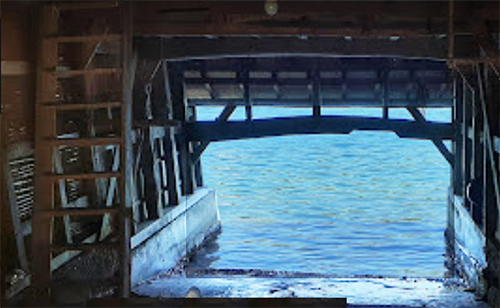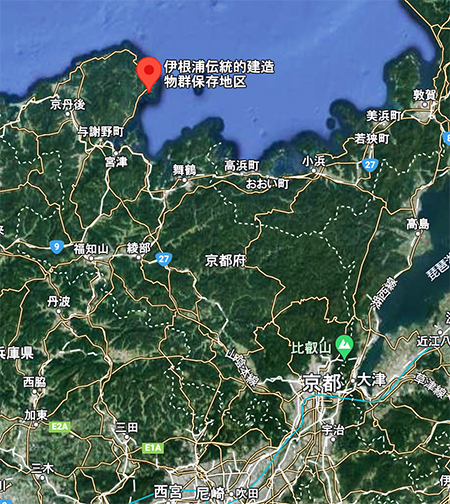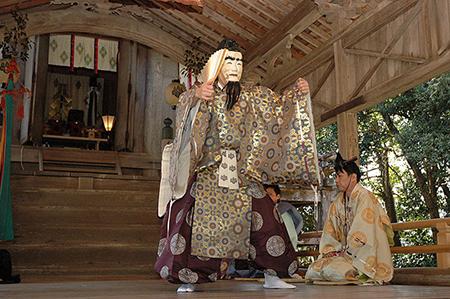


きのう書いた伊根の暮らしよう、その続篇です。丹波地域は古代史を深掘りしていると非常に重要な地域と言うことが知れてくる。ヤマト王権が大和国に覇権を確立した当時、国譲り神話の出雲、桃太郎伝説の吉備・岡山地域とともに丹波地域が重要な先進地域とされる。環日本海としての位置関係からは、出雲ともつながりが考えられるのだけれど、ヤマト王権とは重層的な婚姻関係を結んだりしている。ほぼ同盟的関係。
この伊根の伝統的住居群には、そういった古代から続く人びとの営み感が強く訴求してくる。日本列島に人びとが定住をはじめた初期のありようが見えてくる気がしてならない。上の写真のように、町家的に集住して海に対しての各戸別での舟でのアクセスを確保させている。現代のマイカーと比肩できるマイボートだろうか。
「漁業」という産業痕跡では、というのはどうも違う。漁業というのは大きな消費市場を想定してそこへの供給という「交易」を前提とした産業形式だけれど、この伊根の舟屋群からは、むしろ小舟での移動交通と日々の食膳に魚を確保するための各戸の「キッチン」の延長のように思える。
やはり基本的な「海民」としてのライフスタイルをそこに感じさせられる。こういう基本的な食料確保手段を前提にして、周辺の植物採集に徐々に生活域を拡大していった。そのときに最高の食糧生産手段は稲作だった、というこの列島での歴史のはじまりを垣間見せてくれるのだと思う。

この伊根には「浦嶋神社」がある。写真はそこで行われている狂言舞台の様子。助けたカメに連れられた、あの日本昔話の主人公を祀っている。以下伊根町のHPより。
〜<浦嶋神社(宇良神社)>昔話でお馴染みの浦島太郎。この話の起源は「日本書記」「丹後国風土記(逸文)」「万葉集」に浦嶋の名が見られることから、七世紀後半。日本各地にその伝承がみられますが、伊根町の浦嶋神社に伝わる浦嶋伝説が最も起源が古いとされています。 浦嶋神社創祀年代は淳和天皇の天長2年(825年)とされ、浦嶋太郎の主人公である浦嶋子(浦島太郎)を筒川大明神として祀るのが初めであると伝えられています。神社には浦嶋明神縁起絵巻(国指定重要文化財)、亀甲櫛笥の玉手箱、乙姫の打ち掛けなどの宝物が受け継がれています。〜
先に触れたように、桃太郎伝承の吉備と浦島太郎伝承のこの伊根を含む丹波は、初源期の日本列島社会のありようのヒントを、今に繋がる生活痕跡として伝えてくれていると思っています。故郷としての日本文化をいったん離れた北海道人だからこそ、こういう初源のカタチに打たれている。
English version⬇
The legend of Urashima remains in the original landscape of “the sea and the Japanese.
The first source of settlement in the archipelago was probably to secure foodstuffs. From this point, agricultural development was developed in the surrounding areas. In the midst of this development, a man called “Urashima Taro” left the floating world…
This is a continuation of the article I wrote yesterday about life in Ine. When you dig deeper into the ancient history of the Tamba region, you will learn that it is a very important region. At the time when the Yamato kingdom established its supremacy over Yamato, the Tamba region was regarded as an important advanced region, along with Izumo in the myth of the handover of the kingdom, and Kibi and Okayama in the Momotaro legend. Although Izumo is considered to be connected to the Yamato kingdom because of its location on the Japan Sea Rim, the Tamba area is said to have had a multilayered intermarriage relationship with the Yamato kingdom. The relationship is almost an alliance.
The traditional dwellings in Ine strongly appeal to the sense of people’s activities that have continued from ancient times. It is hard not to see the early days of human settlement in the Japanese archipelago. As shown in the photo above, the houses are clustered together like townhouses, and each house has its own access to the sea by boat. I wonder if these boats are comparable to today’s private cars.
It is not the same as the industrial traces of “fishery”. Fishing is an industrial form based on the assumption of a large consumer market and the “trade” of supplying that market, but the boathouses in Ine seem more like an extension of the “kitchen” of each house, where small boats were used for transportation and to secure fish for the daily meals.
It is as if we can feel the basic lifestyle of “sea people” in these boathouses. Based on this basic means of securing food, they gradually expanded their living area to gathering plants in the surrounding area. I believe that this is a glimpse into the beginning of the history of this archipelago, in which rice cultivation was the best means of food production at that time.
There is a “Urashima Shrine” in this Ine. The photo shows a kyogen stage being held there. The shrine enshrines the hero of a Japanese folk tale who was taken by a rescued turtle. The following is from the Ine Town website.
〜<Urashima Shrine (Ura Shrine) > Urashima Taro is a well-known character in Japanese folk tales. The origin of this story can be traced back to the late 7th century, as the name of Urashima is found in the “Nihon shoki” (the oldest chronicle in Japan), “Tango kuni fudoki (anecdotes)” and “Manyoshu” (the oldest anthology of Japanese poetry). The legend of Urashima can be found in many places in Japan, but the legend of Urashima at the Urashima Shrine in Ine-cho is said to be the oldest. The shrine is said to have been founded in 825 by Emperor Junna (825), and is said to have first enshrined Urashima Taro’s hero, Urashima Ko (Urashima Taro), as Tsutsukawa Daimyojin (Great God of Tsutsukawa). The shrine has inherited such treasures as the Urashima Myojin Engi Emaki (designated as a National Important Cultural Property), the Turtle Shell Comb Chest of Tamatebako, and Otohime’s Uchikake. ~.
As mentioned earlier, Tamba, including Kibi with its legend of Momotaro and Ine with its legend of Urashima Taro, has passed on hints of the society of the Japanese archipelago in the Early Genesis period as traces of the way of life that are still relevant today. It is precisely because I am a Hokkaido native who has once left Japanese culture as my hometown that I am struck by this form of Hatsugen.
Posted on 4月 14th, 2023 by 三木 奎吾
Filed under: 日本社会・文化研究, 歴史探訪







コメントを投稿
「※誹謗中傷や、悪意のある書き込み、営利目的などのコメントを防ぐために、投稿された全てのコメントは一時的に保留されますのでご了承ください。」
You must be logged in to post a comment.